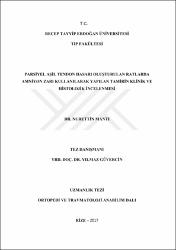| dc.description.abstract | İnsan vücudunun en güçlü tendonlarından olan aşil tendonu, spor yapan özellikle orta yaş üstü popülasyonda sık bir yaralanır. Tendon onarımları sonrası adezyon gelişimi ortopedik cerrahlar için sorun olmaya devam etmektedir. Diğer yumuşak dokular ve tendonlarla karşılaştırıldığında, aşil tendon iyileşme süreci uzundur, bu durum muhtemelen kanlanmasındaki zayıflığa bağlı sitokin ve büyüme faktörlerinin iyileşme sürecini etkilemesindendir. İdeal tedavi yaklaşımı ve aşil tendon iyileşmesi üzerinde tartışmalar devam etmektedir. Bu çalışmamızda insan kaynaklı amniyotik membranın tendon iyileşmesinde adezyon, anjiogenez ve inflamatuar süreç üzerine etkileri araştırılmıştır. Amniyon zarının anjiogenez ve inflamasyona etkisi VGF, MMP-2 ve MMP-9 IHC kitleri kullanılarak, adezyon üzerine etkisi ise Tang ve ark. yaptığı sınıflamayla histolojik olarak değerlendirilmiştir. Çalışmamız, 35 adet rat üzerinde 5 farklı grupta yapıldı ve her ratın sol alt ekstremitesi kullanıldı (n: 7). Kontrol grubuna hiçbir işlem uygulanmadı, diğer gruplara aşil tendonun yarısına parsiyel kesi uygulandıktan sonra sırasıyla primer tamir (grup 1), sutur atılmaksızın amniyon zarı uygulanması (grup 2), primer tamirle beraber amniyon zarı uygulanması (grup 3), ve tamir uygulanmadan sekonder iyileşmeye bırakma (grup 4) uygulandı. 60 gün iyileşme süreci sonunda 35 adet ratın aşil tendonları histolojik değerlendirmeye alındı. Histolojik ve istatistiksel değerlendirme sonucunda; amniyotik membranın tendon iyileşmesinde kullanılmasının adezyon gelişimini azalttığı, kollajen diziliminde pozitif yönde etkili olduğu, antienflematuar etkilerinin bulunduğu görülmüştür. Ek olarak VGF değerlendirilmesinde, amniyotik membran kullanılarak tamir edilen grupların birbirleri arasında fark çıkmazken, amniyotik membran kullanılarak tamir edilen gruplarla kontrol grubuna kıyasla VGF pozitivitesinde artış görülmüştür. Sonuç olarak; doku üzerinde amniyotik membranın biyolojik davranışını değiştirebileceğini ve yüzeye bağlı anjiyogenezi indükleyebileceği, iskemi inflamasyon gibi durumlarda kullanımında genel kanının aksine anjiogenetik etki gösterebileceğini düşündürmüştür, ancak bu konuda karar verebilmek için daha fazla araştırmaya ihtiyaç vardır. The Achilles tendon, one of the most powerful tendons of the human body, is frequently injured in sports, especially in middle age populations. Adhesion development after tendon repair still continues to be a problem for orthopedic surgeons. When compared to other soft tissues and tendons, the Achilles tendon healing process is prolonged, which probably due to the weakness of the blood supply and the cytokines and growth factors that influence the healing process. Discussions continues about the ideal treatment approach and the recovery of achilles tendon. In this study, we investigated the effects of the human amniotic membrane on adhesion, angiogenesis and inflammatory process in tendon healing. Effects of amniotic membrane on angiogenesis and inflamation were evaluated via MMP-2 and MMP-9 IHC kits and effects on adhesion were estimated histologically by using classification of Tang at all. Our study was performed in 5 different groups on 35 rats and the left lower extremity of each rats was used (n: 7). In the control group ( group 5), there wasn't any intervention. In the other groups after partial achilles cut in the group 1 primary repair applied, in the group 2 amnion membran without suture, in the group 3 amnion membrane application with primary repair was done and in the group 4 without any treathment secondary healing observed. At the end of the 60 day recovery period, 35 rats' Achilles tendons were histologically evaluated. As a result of histological and statistical evaluation; it was seen that amniotic membrane decreases development of adhesion, positivelly effects collagen sequence and has antiinflamatory effects in tendon healing. In addition VGF positivities were increased in the amnioticmembrane repair groups when compared to control group but there wans't any difference among amniotic membrane repair groups. As a result we suggest that the amniotic membrane on the tissue can change the biological behavior, may induce surface-bound angiogenesis and quite the contary induce angiogenetic effects in the ischemia and inflammation but to make a conclusion about this issue we need more researchs on this topic. | en_US |


















